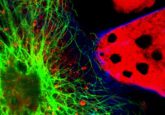Breast cancer immune ‘hotspots’ detected by criminology software
Images of ‘hotspots’ of immune reaction to tumors could potentially be utilized to predict the survival of women with breast cancer. The new test, which has been developed by researchers at The Institute of Cancer Research (ICR; London, UK), was described recently in Modern Pathology.
The test utilizes statistical software, previously used in criminology, to track the extent to which an individual’s immune system is targeting and attacking breast cancer cells. Consequently, it may provide the ability to evaluate whether a patient’s immune system is working to prevent cancer development, and ultimately identify individuals who will need more intensive treatment to combat their more aggressive disease.
The team of researchers analyzed tumor samples taken from 245 women who had been diagnosed with estrogen receptor-negative breast cancer. Applying computerized imaging of the tumor samples and statistical analysis, the ICR team were able to measure the number of immune cell ‘hotspots’.
The analysis indicated that hotspot images highlighting where immune cells were spatially clustered around breast cancer cells provided a better measure of immune response when compared with a simple count of the numbers of immune cells within a tumor.
Subsequently, the women within the study were split into two groups based on the numbers of immune hotspots identified within their tumors. It was demonstrated that individuals with higher numbers of hotspots lived on average 91 months before metastasis of their cancer. By contrast, those with a low number of hotspots lived on average 64 months before cancer spread.
Importantly, the newly developed test represents the first objective method to measure the strength of a patient’s immune response to their own tumor. The team also believe that this automated analysis could be complementary to existing microscopic examination where tumor samples are observed to gain a sense of the strength of the immune response.
“This study has found an ingenious way to generate and understand data from images of biopsy samples, which are already taken from patients but not analyzed in a mathematical way. The interaction between the immune system and cancer is extraordinarily complex, and something we are only just beginning to understand. But just as there are high hopes for immunotherapy as a future cancer treatment, we also believe that this new way of measuring immune reaction could be used to tailor treatment more effectively to individual patients,” commented Paul Workman (ICR).
Philip Nelson from the Engineering and Physical Sciences Research Council added: “We are excited by the prospect that such advances in computational methods might one day be used in mainstream healthcare, leading to facilitating improvements in a patient’s prognosis. This study demonstrates the importance of engineering, physical sciences and mathematical sciences, which contribute to our understanding of cancer, its progression and treatment.”





